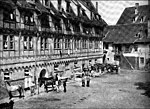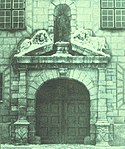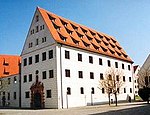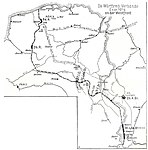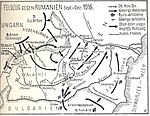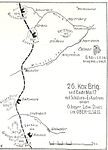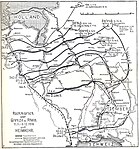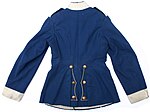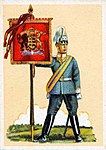Dragoon Regiment "Queen Olga" (1st Württembergisches) No. 25
|
Dragoon |
|
|---|---|

|
|
| active | 1806 to 1919 |
| Country |
|
| Armed forces | German Army (German Empire) |
| Armed forces | army |
| Branch of service | cavalry |
| Type | Cavalry Regiment |
| structure | See outline |
| Location | See garrisons |
| march | Presentation march: "Graf Eberhard-Marsch" (A III, 63; BI, 47) Parade march : Parade march (A III, 10) |
| management | |
| Commanders | See list of commanders |
The dragoon regiment "Queen Olga" (1st Württemberg) No. 25 was from 1806 (1813) to 1919 a regiment of the Württemberg army . In their last station in Ludwigsburg, they were also known colloquially as the white dragoons .
history
Surname
The Leib-Chevauxlegers Regiment was formed in 1806 with four squadrons and renamed Leib-Chevaulegers Regiment No. 2 in 1811 . The regiment had belonged to the Normann Brigade in 1813 . On his return to Ludwigsburg on November 19, 1813, the commander was dismissed and on November 17, 1813 the regiment was renamed Jäger-Regiment Nr. 4 Prinz Adam . When the army was reorganized, the regiment was named 4th Cavalry Regiment on March 31, 1817 .
By a decree of King Charles of December 19, 1864, the earlier tradition was continued and the names of some regiments expanded, the regiment was given the addition of 4th Cavalry Regiment Queen Olga . In 1870 it was renamed the 1st Dragoon Regiment Queen Olga and on October 2, 1871 the 1st Württemberg Dragoon Regiment Queen Olga. On December 18, 1871, all Württemberg regiments received additional numbers. These corresponded to the consecutive numbering of all regiments of the German Armed Forces, regardless of their affiliation to one of the contingents, the regiment was given the number 25 1st Württemberg Dragoon Regiment Queen Olga No. 25 . On December 14, 1874, all of the Württemberg troops were given the names in their final spelling and numbering: Dragoon Regiment "Queen Olga" (1st Württemberg) No. 25 .
The regiment was disbanded on May 1, 1919.
The tradition of the regiment was taken over by the 1st (Württemberg) squadron of the 18th cavalry regiment in the Reichswehr .
Garrisons
- 1813 Ludwigsburg
- 1814 Kirchheim (in Schloss Stab and 2 squadrons), and Nürtingen (barracks, later Gasthaus zum Stern, 2 squadrons)
- 1815 occupation in France ( Lauterburg )
- 1818 Ulm armory barracks
- 1833 Ludwigsburg
- 1838 Esslingen am Neckar
- 1845 Stuttgart , Reiterkaserne (on the site of the later freight yard)
- 1852–1919 Ludwigsburg, barracks on Arsenalplatz, Reiterkaserne on Karlsplatz (today Building Department), 1906 Queen Olga barracks
Former Queen Olga barracks in Ludwigsburg
Participation in skirmishes and combat operations
- 1805 with France against Austria, strength 19 officers, 5 surgeons, 28 NCOs, 336 Chevaulegers, 9 trumpeters, 5 blacksmiths, 1 profoss , 1 flag saddler, 1 gunsmith, 320 horses in 4 squadrons. No fighting.
- 1807 with France in the Württemberg cavalry brigade under Count Montbrun against Prussia, strength 15 officers, 477 NCOs and Chevaulegers and 421 horses in 4 squadrons. Fights in front of Glogau , Breslau , Schweidnitz , Neisse , attacks near Strehlen , Stephansdorf and Heilsberg . As a replacement, 2 officers, 179 NCOs and Chevaulegers and 153 horses were brought up. Total losses 25 killed, 13 deceased, 69 wounded (including the commander), 3 missing, 8 deserted.
- 1809 with France in the VIII. Army Corps Vandamme , strength 22 officers, 574 NCOs and Chevaulegers as well as 511 horses in 4 squadrons. Fights near Riedau, Abensberg , Landshut , Eggmül and Regensburg . Losses unknown.
- 1812 Russian campaign 1812 with France in the II. Army Corps Ney , strength 22 officers, 580 NCOs and Chevaulegers as well as 519 horses in 5 squadrons. Strength on September 15, 1812 7 officers and 120 NCOs and Chevaulegers, on September 15, according to the report, 6 officers, 16 NCOs, 64 Chevaulegers, 3 doctors, 6 trumpeters, 7 train soldiers, 10 boys and 105 horses, in the hospital 8 officers (among them the commander) and 173 NCOs and Chevaulegers, commanded 2 officers, 23 NCOs and Chevaulegers, 19 horses. On October 24, 1812, both Chevaulegers regiments were combined into one squadron (under the command of the 1st regiment, Colonel von Palm): 1st platoon, regiment No. 1, 2nd platoon, regiment 2, 3rd platoon, 10 officers from both regiments . At the end of December 1812, 17 officers, 1 doctor, 2 sergeants, 7 NCOs, 3 trumpeters and 36 Chevaulegers gathered in Marienwerder .
- 1813 in the Normann Brigade , strength 22 officer, around 600 NCOs and Chevaulegers, losses unknown.
- 1814 against France with the main army in the 2nd Brigade (von Jett) of the Cavalry Division (Prince Adam) , IV Army Corps (Crown Prince Wilhelm von Württemberg ), strength 21 officers and around 500 NCOs and hunters. Assignments at Neu-Breisach , Chaumont , Brienne , Montereau , Arcis-sur-Aube and Fère-Champenoise (losses: 6 killed, 1 deceased, 25 wounded, 2 missing and 16 dead, 28 wounded and 2 missing horses). Total losses unknown.
- 1815 in autumn against France in III. Corps of the Upper Rhine Army again in the brigade of Jett of the Prinz Adam cavalry division , strength 25 officers, 580 NCOs and hunters and 519 service horses. Fighting at Saarburg , Hagenau , in Strasbourg , attack in Souffelweyersheim (losses 49 wounded, 8 missing). Total losses unknown.
- From 1847 to 1849 the regiment was deployed in the May riots in 1847 to restore order in its Stuttgart garrison. In September 1848 two squadrons moved into outpost positions near Plieningen , the 3rd squadron was relocated to Rottweil with the 4th infantry regiment and a battery . After the outbreak of the Baden Revolution , the regiment was sent in a mixed brigade to the Knittlingen - Illingen area . From there, two squadrons relocated to Heilbronn to the vigilante group to disarm, the other two squadrons came to the Observation Corps .
- 1866 against Prussia in the reserve cavalry of the VIII Federal Corps , strength 21 officers, 583 NCOs and riders, 592 riding horses and 30 draft horses, plus the 3rd Squadron of the 2nd Cavalry Regiment subordinate to the regiment. Deployed to the Cavalry Reserve of the VIII Corps of the German Confederation, the regiment was stationed in Offenbach am Main from June 18 , in Vilbel from June 21 , and in the Friedberg area from June 25 . On June 29th the regiment was split up: 1st to 3rd squadrons marched with the main forces to Heblos (July 3rd), the 4th and 5th squadrons with the Fischer Brigade to Herbstein (July 5th). Then the regiment, reunited since July 12, marched back to the south-west with the 3rd Brigade of the Württemberg Division from the area west of Frankfurt. On July 24th, regimental commander von Gukelen undertook a reconnaissance ride with the 2nd and 3rd squadrons beyond Hardheim , but had to go back in front of superior Prussian troops (losses of 1 wounded, 3 prisoners, 8 missing, 1 dead, 3 wounded and 7 missing horses ). At the command post to Tauberbischofsheim the regiment in position with was Großrinderfeld , not directly involved and went to the corps Würzburg back. After the armistice on August 1, the regiment returned to Stuttgart via Gaukönigshofen , Rothenburg ob der Tauber , Langensteinbach (arrival August 16). Total losses: 5 dead, 4 prisoners, 4 missing.

- 1870/1871 against France . The Wuerttemberg cavalry brigade was assigned to the Baden division in advance until the Wuerttemberg mobilization was completed and on July 22nd moved with 15 officers, 607 NCOs and men, 555 riding horses and 28 draft horses by train to Durlach , united on July 25th Rastatt , where the missing 85 men and 76 horses arrived, with the 1st Cavalry Regiment (4 squadrons) and the 3rd Cavalry Regiment (2 squadrons) to the Württemberg cavalry brigade under Major General Graf von Scheler and was until 29 July deployed to the outpost service on the Rhine in the Muggensturm area. From July 31, the brigade belonged again to the Württemberg field division , which in turn belonged to the Werder corps from August 2 . The division crossed the Rhine at Maxau over a ship bridge on August 4 and entered French soil above Lauterburg the following day . It was used on August 6 in the battle of Wörth . With the Württemberg field division from August 7th with the V (Prussian) Army Corps, the regiment came into action on September 1st at Mézières . On September 4th the regiment came to the 1st Field Brigade (Major General Frhr. Von Reitzenstein) and stayed there until the end of the war. During the siege of Paris the regiment stood at Villiers-sur-Marne - Champigny-sur-Marne - Noisy-le-Grand . During the Battle of Villiers the regiment was in reserve. After the preliminary peace at Versailles in 1871, the division moved to Champagne , the regiment moved to quarters in and near Châlons-en-Champagne from March 13 , and marched back to Württemberg from May 31. On June 28, the field division was disbanded and the regiment returned to its garrison in Ludwigsburg on June 29. Casualties: 3 killed and 6 wounded.
- In 1900 , 7 NCOs and 14 Dragoons participated in the second international expeditionary force in China, no losses.
- In 1904/1906 2 officers, 4 NCOs and 14 dragoons took part in the fight against the Herero . Losses: 3 killed, 3 deceased, 3 wounded.
- 1914/1918 With the mobilization for World War I , the regiment came to the 26th Cavalry Brigade (Major General Robert Herzog von Württemberg), 7th Prussian Cavalry Division in the 6th Army, which was set up in Saarlouis in August 1914 . The strength after mobilization was 37 officers, 2 doctors, 1 veterinarian, 1 purser, 683 NCOs and men, 786 horses and 19 vehicles. The operations of the regiment are described in the division.
On October 23, 1914, the regiment's riflemen were first assembled and deployed in a squadron.
When he returned on November 30, 1918, the regiment had a strength of 8 officers and 262 NCOs and men. Losses: 261 killed (partly among the infantry and the air force).
assignment
The order of the regiment was the training of the soldiers for reconnaissance ( patrol service ), flank security and as messenger riders as well as the further training of the remonts .
organization
Association membership
Until 1816 there were no major associations in Württemberg during peace . Such were only put together for individual campaigns.
With the fundamental reorganization in 1817, the Württemberg army was divided into large units for the first time in peacetime. The cavalry was divided into a division with two brigades, with the 1st cavalry regiment the regiment formed the 1st brigade. From 1833 to 1842 the regiment belonged to the 2nd Brigade. In July 1849 the division ceased to exist and the cavalry regiments were combined in one brigade. On September 13, 1852, this brigade was renamed Division again. From 1871 to 1914 the regiment belonged to the 26th Cavalry Brigade (1st Royal Württemberg) in Stuttgart , ( 26th Division (1st Royal Württemberg) , XIII (Royal Württemberg) Army Corps , 5th Army).
At the beginning of the First World War, the peace structure was dissolved and the regiment with four field squadrons of the 26th Cavalry Brigade in the 7th Cavalry Division .
structure
The regiment was divided into 4 squadrons from its formation, on July 13, 1807 a 5th squadron was added.
In 1820 the peacetime strength of the regiment was 17 officers, 67 NCOs, 264 riders and 2 non-combatants as well as 345 riding horses in four squadrons. In order to bring it to full military strength, 8 officers, 54 NCOs (including 10 doctors), 381 crews (including 64 riflemen with special training), 5 drivers recalled from vacation or called up and trained reservists or recruits as well as 462 riding horses must be procured and trained.
During the mobilization in 1914, the regiment was reorganized
- 1st squadron became 1st field squadron
- 2nd squadron became replacement squadron
- 3rd squadron became 2nd field squadron
- 4th squadron became 3rd field squadron
- 5th squadron became 4th field squadron
The strength after the mobilization in 1914 was 37 officers, 2 doctors, 1 veterinarian, 1 paymaster, 683 NCOs and men, 786 horses and 19 vehicles. On November 30, 1918, the strength was 8 officers and 262 NCOs and men.
Commanders
| No. | Rank | Surname | Beginning of the appointment | comment |
|---|---|---|---|---|
| 1. | Mr. by Hayn | October 6, 1805 | ||
| 2. | de l'Estocq | August 26, 1806 | ||
| 3. | Mr. from Röder | September 26, 1807 | ||
| 4th | by Wambold | August 20, 1808 | ||
| 5. | from Walsleben | January 24, 1809 | ||
| 6th | Colonel | Karl Graf von Normann-Ehrenfels | December 16, 1810 | 1813 Commander of the Normann Brigade |
| 7th | Prince Friedrich von Oettingen-Wallerstein | May 21, 1813 | ||
| 8th. | Ludwig Frhr. from Gaisberg | November 17, 1813 | then again in command of 2nd Cavalry Regiment May 8th 1828 Commander 2nd Cavalry Brigade May 1st, 1848 farewell |
|
| 9. |
Major February 2, 1814 Lieutenant Colonel June 11, 1815 Colonel |
Karl Albrecht von Reinhardt | December 9, 1813 | then commander of the 1st Cavalry Regiment |
| 10. | Colonel | Johann August Wilhelm von Milkau | December 31, 1819 | March 23, 1821 Commander Ehren-Invaliden-Corps † February 1, 1849 on Comburg |
| 11. | Colonel and adjutant to the king |
Georg Graf von Sontheim | March 23, 1821 | January 1, 1826 Major General and Commander of the 1st Reiter Brigade September 15, 1842 Lieutenant General and Governor of the Federal Fortress of Ulm October 5, 1857 Farewell |
| 12. | Colonel | Ludwig August von Bassewitz | January 1, 1826 | March 25, 1828 farewell |
| 13. | Colonel | Ludwig Wilhelm Count von Graevenitz | March 25, 1828 | † December 2, 1841 |
| 14th | Colonel | Karl von Finkh | December 13, 1841 | December 18, 1848 to the Honorary Invalid Corps |
| 15th | Colonel | Count of Linden | December 18, 1848 | January 5, 1857 as major general in command of the Reiter Division |
| 16. | Colonel | Count von Scheler | January 5, 1857 | March 5th as major general commander of the Reiter Division, November 2nd 1868 governor of Stuttgart, during the campaign 1870/1871 commander of the cavalry brigade, October 25th 1871 character as lieutenant general, † March 29th 1887 |
| 17th | Colonel | Gustav Philipp von Gukelen | March 5, 1866 | June 18, 1868 farewell |
| 18th | Colonel | August Graf von Normann-Ehrenfeld | July 14, 1868 | Transferred to army officers on December 11, 1871, put up for disposal in the regiment's uniform on May 20, 1872 , † January 16, 1893 |
| major | Karl August Frhr. from Röder | May 8, 1871 leader of the regiment |
||
| 19th | (Royal Prussian.) Colonel | Ferdinand Heinrich von Massow | December 18, 1871 | November 30, 1874 Commander of the 27th Cavalry Brigade |
| 20th | Lieutenant colonel | Karl August Frhr. from Röder | September 13, 1872 leader of the regiment March 3, 1873 commander |
September 25, 1874 Farewell, † July 20, 1889 |
| 21st | Major March 1, 1875 Lieutenant Colonel March 3, 1879 Colonel |
Wilhelm Friedrich Ludwig von Kurtz | September 28, 1874 | January 1, 1884 Commander of the 22nd Cavalry Brigade , May 21, 1885 Farewell, † October 13, 1886 |
| 22nd | Lieutenant Colonel March 15, 1887 Colonel |
Nikolaus Petrus Philomenus von Karass | January 11, 1884 | July 6th 1888 farewell, February 24th character as major general , † March 15th 1906 |
| 23. | Lieutenant Colonel March 24, 1890 Colonel |
Wilhelm Johann Alfred von Sick | July 15, 1888 | January 27, 1892 Commander of the 14th Cavalry Brigade , June 21, 1896 Major General and Commander of the 1st Guard Cavalry Brigade , January 27, 1897 Commander of the 27th Division (2nd Royal Württemberg) , June 4, 1899 Governor of Strasbourg , September 19, 1901 Character as General of the Cavalry , April 3, 1903 Farewell, † December 27, 1906 |
| 24. | Major March 29, 1893 Lieutenant Colonel April 18, 1896 Colonel |
Eberhard Karl Reinhard von Röder | January 27, 1892 | May 20, 1897 Commander of the 27th Cavalry Brigade |
| 25th | (Royal Prussia) Lieutenant Colonel | Klaus Christin Werner von Bredow | May 20, 1897 leader of the regiment June 17, 1897 commander |
August 18, 1901, transferred back to Prussia as brigade commander |
| 26th | Colonel | Prince Ernst of Saxe-Weimar-Eisenach | August 18, 1901 leader of the regiment April 22, 1902 commander |
April 10, 1906 Leader of the 21st Cavalry Brigade, later its commander |
| 27. | Colonel | Duke Wilhelm Karl of Urach | April 10, 1906 | September 10th Commander of the 26th Cavalry Brigade, March 22nd, 1910 Major General, September 13th 1913 Lieutenant General, September 21st, 1912 Commander of the 26th Division |
| 28. | Major August 18, 1908 Lieutenant Colonel July 19, 1911 Colonel |
Max Otto Frhr. Thumb from Neuburg | July 21, 1908 | |
| 29 | Major 1st October 1913 Lieutenant Colonel |
Franz Maria Gerold von Gleich | January 27, 1913 leader of the regiment February 23, 1913 commander |
then the staff of the stage section VII |
| 30th | Major June 1915 Lieutenant Colonel |
Mr. Hans Wolfgang Capler von Oedheim called Bautz | December 11, 1914 | died May 2, 1917 |
| 31. | Lieutenant colonel | Ebner | May 1917 | July 10, 1918 transferred to army officers |
| 32. | major | Landbeck | July 10, 1918 | |
| Rittmeister | Mr. from Wöllwarth | Regimental leader | ||
| 33. | Rittmeister | Karl Jobst | July 10, 1918 |
Regimental owners and chiefs
- October 6, 1805 to November 8, 1813 Elector Friedrich II.
- November 17, 1813 to November 19, 1816 Prince Adam Karl Wilhelm of Württemberg
Heads of regiments
- December 19, 1864 to October 30, 1892 Queen Olga of Württemberg
- September 7, 1909 Kaiser Wilhelm II.
Armament and equipment
Main armament
When it was set up, the armament consisted of a musket with a bayonet , a long pistol studded with brass, and a crooked saber. In 1818 the riders (in May only those in the first ranks, in November all of them) received a lance and short carbine so that they were armed with a lance, short carbine, saber and pistol. The riflemen had no lance, but a long carbine. In 1840/41 the cavalry received the first carbines with percussion locks and the pistols were omitted. From then on, every rider was trained in the skirmish service .
In 1868 the cavalry received a new saber, 32 men in each squadron received Prussian needle guns, the rest of them instead of more smoothly drawn percussion pistols.
In 1875 the regiment received modified Chassepot carbines , and in 1877 the M 71 carbine . In 1890 the regiment was equipped with the carbine 88 and tubular steel lances. In 1909 the Karabiner 98 was introduced.
Other equipment
On November 15, 1868, the cavalry received the helmet based on the Prussian model.
In 1890 the army saddle was introduced in place of the previous buck saddle .
In 1900 a new cavalry telegraph was introduced, which from 1908 was carried in a two-horse carriage in the battle baggage.
1914 belonged to
- Battle baggage
- of the regimental staff 10 hand horses, 2 medical pack horses, 2 riding horses of the pack horse leaders, 1 two-horse cavalry medical car, 2 six-horse cavalry bridge cars, 1 two-horse telephone car;
- the squadron 12 hand horses;
- Big baggage
- of the regimental staff 1 four-horse staff baggage car, 1 two-horse food wagon, 1 four-horse feed wagon;
- the Eskadron 1 two-horse Eskadron baggage car, 1 two-horse grocery car, 1 four-horse feed wagon.
Field kitchens were not introduced to the cavalry until 1915.
uniform
- 1806: Dark blue collet with scarlet borders , collar and belt, armored paulettes made of white metal. White leather breeches. Tall black boots. High Kaskett black leather with white fog, black comb with long horsehair plume up on the shoulder. White leather stuff.
- 1807: For the attack near Strehlen on December 24, 1807, the regiment received four white (officers silver) braids on the borders and on the collar.
- 1810: Black, red edged borders with two rows of buttons, only one strand on the collar.
- 1816: Green collar with two rows of buttons, red collar with white braid, armored paulettes, Polish lapels with red piping . Green pants. White hussar boots with white braid. Black gauntlets. Black lacquered shako with brass fittings. Black leather stuff.
- 1816: Royal blue kutka without buttons, collar and lapels blue with red piping, yellow armored paulettes. Long blue pants. Red shako with blue stripe above and black and red cockade . White leather stuff.
- 1844: Light blue short jacket with a row of heads, red collar, armpit flaps and lapels. Long, light blue trousers with red piping. Red shako with a black stripe on top, brass shield and chains and cockade. White leather stuff.
- 1849: Long, light blue tunic with a white belt. Shako with falling black bush.
- 1874: Uniform according to Prussian standards, but still (until 1892) double-breasted tunic with yellow buttons and white collar, lapels and lugs, on the white field of the red padded epaulettes, armpits and armpit flaps the name "O", bandolier and buckle belt made of white leather ( Officers golden), dark blue trousers with leather trimmings, tall boots, helmet with nickel silver fittings and coat of arms and a white plume
- In 1889 officers received silver braids, NCOs and men white braid on the collar and lapel.
- 1890: Name "O" with a crown on the armpits, shoulder pieces and epaulettes.
- From 1908 the first sets of the field gray uniform appeared.
banner
As with all regiments, the flags were replaced by standards on October 4th, 1818, which were replaced by new standards by the Supreme Order of September 3rd, 1851. Each squadron received a standard made of burgundy cloth with orange fringes on all sides. In the middle of one side was the gold and yellow crowned name “W”, the other side the Württemberg coat of arms held by a yellow deer and a black lion, the inscription “Feartlos und trew” on a blue foreign exchange ribbon and the white cross of the Order of Military Merit .
Others
Lieutenant Frhr won the Kaiser Prize for endurance rides . von Lindenfeld (three times), Frhr. from Validingen, from Körber.
In July 1898 the whole officer corps of the regiment carried out a four-day long ride to Friedrichshafen and back exclusively on service horses and without failures: 1st day 125 km, 2nd day 58 km, 3rd day rest day, 4th day 190 km.
Persons in the regiment
- from February 25, 1840 Count Alexander von Württemberg (born November 5, 1801 in Copenhagen; † July 7, 1844), July 18, 1837 as a lieutenant colonel in the regiment, September 26, 1838 Colonel,
- from August 4, 1871 Rittmeister August Jaromir von Gleich (* July 14, 1832; † April 1, 1892)
- from March 6, 1889 Colonel Franz Paul Herzog von Teck (* August 27, 1837 - January 21, 1900)
- from April 10, 1906, Colonel Prince Ernst of Saxe-Weimar-Eisenach
- from September 10, 1908 as Colonel Duke Wilhelm Karl von Urach
Others
- Karl Wilhelm Friedrich von Veiel (born September 23, 1817 - March 11, 1890) joined the regiment on May 20, 1839 as a second lieutenant, June 15, 1846 as a first lieutenant in the 1st cavalry regiment , January 30, 1854 Rittmeister, April 5 1866 Major, 11 June 1866 returned to the regiment, 13 September 1866 to the 2nd Cavalry Regiment, 15 December 1866 Lieutenant Colonel and commander of this regiment, 13 May 1868 Colonel, 20 July 1870 Commander of the reserve cavalry, 5 March 1811 made available. March 5, 1881 Character as Major General.
- Karl Albert von Knoerzer (born May 10, 1858 in Stuttgart, † June 4, 1932 in Stuttgart) came to the regiment on June 30, 1882 as a prime lieutenant. Further career: March 29, 1892 Captain in the General Staff , November 24, 1892 Rittmeister and Wing Adjutant of the King, back in the regiment as squadron chief on February 23, 1895, Major on February 24, 1897 Major, September 10, 1897 in the General Staff, then in the staff of the 27th Division (2nd Royal Württembergische), then teacher at the military academy and department head in the Great General Staff, April 18, 1906 Lieutenant Colonel, March 10th 1904 Commander of the Uhlan Regiment "King Wilhelm I." (2nd Württembergisches) No. 20 , April 10, 1906 Colonel, February 25, 1909 Commander of the 27th Cavalry Brigade (2nd Württembergische), April 20, 1910 Promotion to Major General , December 18, 1912 Inspector of the IV Cavalry Inspection , February 3, 1913 Promotion to Lieutenant General , put up for disposal on June 27, 1914 . With the outbreak of the First World War on August 2, 1914 commander of the 30th Reserve Division, January 18, 1916 commander of the 54th Reserve Division (2nd Royal Württembergische) , July 1917 commander of the 7th ( Württemberg ) Landwehr Division , 15. February 1918 Commanding General of the Knoerzer Corps , February 25, 1918 Character as General of the Cavalry . On October 3, 1918, the Knoerzer Corps was disbanded, and General von Knoerzer took over command of the 7th (Württemberg) Landwehr Division.
- Hermann Karl Friedrich Reinhard Frhr. von Röder (born April 14, 1856; † ??), joined the regiment as Prime Lieutenant on June 9, 1884, Rittmeister on May 8, 1889, and January 17, 1891 in the Uhlan Regiment "King Karl" (1st Württembergisches) No. 19 , September 24, 1892 Wing adjutant of the King, February 23, 1885 Major, October 18, 1897 Dragoon Regiment No. 2, June 16, 1901 Lieutenant Colonel and Commander Kurmärkisches Dragoon Regiment No. 14 , May 17, 1904 Colonel, later Commander 33 Cavalry Brigade .
References
swell
- Main State Archive Stuttgart : Holdings M 160
literature
- Starkloff: History of the Royal Württemberg fourth cavalry regiment, Queen Olga 1805-1866 , Verlag Karl Aue, Stuttgart, 1867
- Karl Spieß, Hans Ritter: History of the Dragoon Regiment Queen Olga (1. Württ.) No. 25 , Ludwigsburg 1913
- Hans Gais: With the Olga Dragoons in the World War . Belser, Stuttgart 1920. (Volume 8 from the series The Württemberg Regiments in World War I )
- Julis Strüder, publisher: Blue and white equestrian stories , Neuwied, 1957
- Otto von Moser: Die Württemberger in World War I , Chr.Belser AG publishing house in Stuttgart, 1927
- Günther Voigt: Germany's armies until 1918. Volume 7, Biblio Verlag, Osnabrück 1986, ISBN 3-7648-1494-2 .
- Leo Ignaz von Stadlinger, History of the Württemberg War , K. Hofdruckerei zu Guttenberg, Stuttgart 1856
- Hans-Joachim Harder: Military history handbook Baden-Württemberg . Edited by the Military History Research Office . Kohlhammer , Stuttgart 1987, ISBN 3-17-009856-X
- Uniforms regulation for the Königlich Würtembergische Militair , Königliche Hof- und Kanzlei-Buchdruckerei Gebrüder Mäntler Stuttgart, 1818
Individual evidence
- ↑ Württ. Government Gazette 1811 Nro. 25, June 1, page 265: “With the intention of reviving the previously established establishment of naming the cavalry and infantry regiments, at the same time also to honor and reward excellent military services in a special way, I think Moved me to dispose of the following: 2. ... I want my name to be given to the 4th Cavalry Regiment and the 1st Infantry Regiment the name of my wife, Queen Olga Majesty and Libden .. "
- ^ By order of the War Ministry Ia No. 17431 the dissolution of the standing army was ordered.
- ^ Spieß, Ritter: p. 225
- ↑ From the estate in the Stuttgart State Archives, M 660/131: “On February 15. In the evening I received the order from General von Linsingen in Osiekrow to join the 7th (Württ.), the 45th (Saxon) L Div and the 2nd Cav. Div as Corps Knoerzer on February 18, on which the The armistice came to an end, the advance began to occupy Luck and Bonno and the Ukrainian government, which had asked for German help, to support the Bolsheviks. "
Remarks
- ↑ Spieß, Ritter S. V: In 1900 the War Ministry established November 17, 1813 as the foundation day. See also: Brigade Normann .
-
↑ Commander Major von Reinhardt
Regular Staff Officer Major von Mögelin
Commander Squadron Staff Cavalier von Mengen
Majors Squadron Mögelin Premier Lieutenant Graf von Reischach
3rd Squadron Major von Moltke (promoted to Lieutenant Colonel after the campaign)
4th Squadron Squadmaster von Thungern -
↑ Commander Colonel von Reinhardt
Regular Staff Officer Lieutenant Colonel von Seidenberger
Commander-Squadron Stabsrittmeister Fhr. Von Podewils
Squadron Seidenberger Stabsrittmeister von Dalbenden
3rd Squadron Major von Raßler
4th Squadron Rittmeister von Völter - ↑ 5th and 7th Infantry Regiment, the regiment, 2 batteries
-
↑ Commander since March 5th Colonel von Gukelen,
staff officer Major Veiel, in the regiment since June 13th,
1st Squadron Rittmeister Graf zu Lippe-Biesterfeld-Falkenflucht
2nd Squadron Rittmeister Neuhaus since the beginning of June
3rd Squadron Rittmeister Link
4th Squadron Rittmeister von Ausin since March
5th Squadron under Rittmeister Rau - ↑ Some of the missing persons on July 24th had rejoined the regiment
-
^ Commander Colonel Count von Normann-Ehrenfels ,
Staff Officer Major Frhr. von Röder
1 squadron Rittmeister Graf zur Lippe-Biesterfeld-Falkenflucht
2nd squadron Rittmeister von Schnizer,
3rd squadron Rittmeister Frhr. von König,
4th Squadron Rittmeister von Karass -
↑ Commander Lieutenant Colonel von Gleich
Major at Staff Major Deyle
1st Squadron Rittmeister von Radowitz
3rd Squadron Rittmeister König
4th Squadron Rittmeister Frhr. von Lindenfels
5th Squadron Rittmeister Schmetzer - ↑ v. Karass was Portepeekadett in the regiment, 25 September 1855 lieutenant, 16 May 1859 first lieutenant, 20 May 1867 Rittmeister, 12 January 1872 transferred to the cuirassier regiment "Graf Gessler" (Rheinisches) No. 8 , 28 September 1874 as head of the Eskdron back to regiment, March 4, 1876 major, December 17, 1883 obet lieutenant
- ↑ v. Sick Portepeekadett in the regiment, February 29, 1864 lieutenant, August 1, 1867 first lieutenant and transferred to the 1st cavalry regiment , March 2, 1872 captain and wing adjutant to the king, December 4, 1876 returned to the regiment as squadron chief, November 23, 1876 Transferred to the Great General Staff , October 19, 1885 to the staff of the Uhlan Regiment "King Wilhelm I" (2nd Württembergisches) No. 20 , October 25, 1886 Plenipotentiary in Berlin, September 26, 1887 Lieutenant Colonel
- ↑ in the regiment since February 24, 1897, but as adjutant to General Command XIII. Army Corps commands
- ↑ July 30, 1884, transferred to the regiment as a second lieutenant, November 1, 1886, to the 26th Dragoon Regiment as a prime lieutenant, August 6, 1887 back to the regiment, February 24, 1892 Rittmeister, August 4, 1992 back to the Dragoon Regiment. regiment. added 26, October 17, 1899 the Guard Dragoons (1st Grand Duchy of Hesse) No. 23 displaced
- ^ 17 October 1899 lieutenant in the regiment, 17 September 1909 first lieutenant, 1 October 1913 surplus captain
- ↑ This saber was supposed to be introduced in 1864, but remained in the arsenals. The 2nd squadron reported about the previous one in February 1866: “The focus is unfavorable, the blades are made of such poor material that they bend over when they are stabbed and remain in this shape, the cutting edge becomes nicks as soon as one blow on hard wood. “Spieß, Ritter, p. 237

